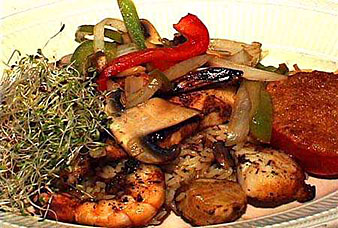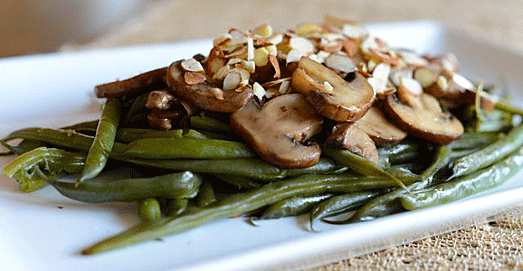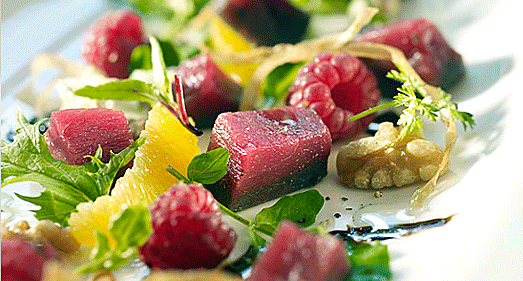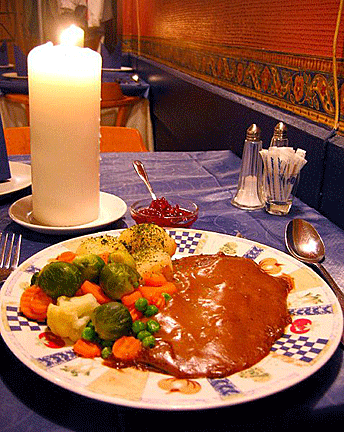Scandinavian
Cuisine—
A Communion With Nature
by Bob Brooke
 The
Scandinavians, widely known as brilliant designers, have designed and
crafted items for the beautification of the table–porcelain, silver
ware, crystal, linen. What isn’t widely known is that they’re
excellent cooks as well. It should stand to reason, however, that a
people who care so much about the way a table looks would also care
about the food that’s put on it. The Scandinavians do. The
Scandinavians, widely known as brilliant designers, have designed and
crafted items for the beautification of the table–porcelain, silver
ware, crystal, linen. What isn’t widely known is that they’re
excellent cooks as well. It should stand to reason, however, that a
people who care so much about the way a table looks would also care
about the food that’s put on it. The Scandinavians do.
Then why is their cooking
relatively unknown? The Scandinavians are in a way themselves to blame.
Having industrialized late and thus begun to emerge from a background of
rural poverty only within the last century, they still tend to see their
native cuisine in humble terms.
So what is Scandinavian
cuisine? It’s many things–fish, pork and poultry, as well as beets,
potatoes, cucumbers, dill, parsley and horseradish, broiled, baked, and
smoked apples. The cooking is pure and simple. Foods taste of
themselves.

Scandinavian ingredients
come from the sea, a fresh-water lake, or even the earth. And some, like
the lingonberry or the mushroom, don’t only come from the forest, but
bring a breath of pines or birches to the table with them. It’s this
palatable communion with nature that makes Scandinavian food appealing.
Scandinavian food is
romantic. There’s something about the fairy tale-curds and whey,
porridge, and fruit tarts. The distant past clings to it. Descendants of
the Vikings today consume some of the dishes the Vikings ate. The
Vikings loved oysters and mussels. They savored mutton, cheese, cabbage,
apples, onions, berries and nuts, and all these continue to be staples
of the Scandinavian diet. The Vikings raised chickens and geese. They
hunted wild birds, elk, deer and bear, just as their modern counterparts
do. Even a few of the more esoteric tastes of the Vikings live on. The
Norwegians insist that a whale steak properly marinated and broiled can
taste as good as beef. Some Swedes rave about smoked horseflesh, which
they refer to as "hamburger" and buy thinly sliced.

To cook the Scandinavian
way is to re-create the past. For hundreds of years many of the recipes
being used today weren’t written down but handed down, like folk
ballads, mouth to mouth, memory to memory. Who can begin to trace the
evolution, much less approximate the age of a dish like herring salad,
eaten for so long and so thoroughly enjoyed that it’s now found not
only throughout Scandinavia, but wherever Scandinavians have gone?
 Scandinavia’s isolation
inevitably helped spawn many local dishes and traditions. Out of the far
North has come one of the greatest Scandinavian delicacies, cured
salmon. Prepared with sugar, salt, white pepper and dill, this moist,
tender, springlike dish is now also relished in Denmark. Scandinavia’s isolation
inevitably helped spawn many local dishes and traditions. Out of the far
North has come one of the greatest Scandinavian delicacies, cured
salmon. Prepared with sugar, salt, white pepper and dill, this moist,
tender, springlike dish is now also relished in Denmark.
In addition to the
isolation of Scandinavia and the isolation of Scandinavians from each
other, something much more elemental has been at work to determine the
character of the food and cooking, and this is climate, especially
winter. Even today winter continues to be the one inescapable fact of
life in the North. The season comes early and lasts long, and, worst of all at least from a
contemporary standpoint, it is dark-drearily so. For centuries, the
thinking of the people was shaped by it, and they devoted their energy
during the short, hectic growing season to making sure that they’d
live through the winter. If many of the foods of the area have a salty
or smoky taste, or are pickled or dried, it’s largely because of
winter. The preservation of foods was the only kind of life insurance,
all important to survival.
The Vikings very early
learned to smoke, dry and salt their meats and fish. And in acquiring
the means to tide themselves over the barren winter, they also found the
means to make their extensive journeys by sea. They took supplies of
nonperishable foods with them, in particular dried cod, which wasn’t
only an excellent source of protein but could be traded abroad.
< Back to A
Taste of Scandinavia
Go to Smǿrrebrǿd > |